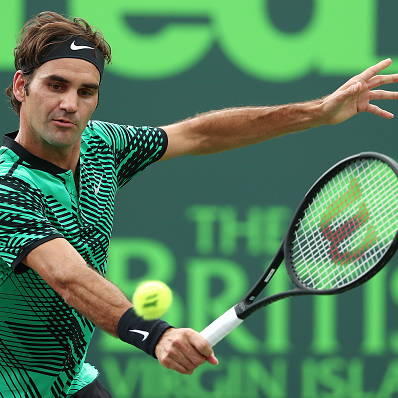Not done yet: Tennis oldies take charge
Federer is in prime form, capping off a stellar 2017 with a win this morning at the Miami Open over old foe Rafael Nadal. HAYDEN WAUGH looks at a modern phenomenon – a bunch of tennis oldies who are refusing to give a new generation room to move.

http://gty.im/657744486
On his way to yet another win ... Federer at the Miami Open..
By HAYDEN WAUGH
Roger Federer’s 2017 Australian Open win – his 18th major – was nothing short of astounding.
It was the perfect way to cap off a stellar career. Yet, he wasn’t done. Federer backed it up with a win at Indian Wells earlier this month, beating Rafael Nadal, Jack Sock and Stan Wawrinka.
And then he did it again today, beating Nadal in the final of the Miami Open.
The form of older players on tour generally fades through sheer age and being overtaken by the new generation.
But, at 35, Roger Federer remains both agile and powerful, and not to be discounted at major tournaments. An aggressive mindset, a revised backhand and, more importantly, an extended 2016 off-season, paves the way for veterans.
Federer contested no tournaments from August 2016 until the Australian Open in January 2017, because of injury.
We rarely hear about such extended off-seasons bearing immense success the following year. From 2007 to 2015, Federer competed, on average, in 16 tournaments a year. In the past 16 months, he’s played in just 10.
This is not only proof that older players can climb the rankings by being more selective about their schedule, it shows that an extended break can do wonders for veterans currently on tour.
http://gty.im/632995730
Age shall not weary him. A triumphant Federer at the Australian Open this year.
Australian Tennis Magazine editor Vivienne Christie said she wasn't surprised that senior stars could overwhelm younger players in today’s tournaments.
“Whether it’s the men’s or women’s game, most players are peaking now after they turn 25, or even later than that,” she said.
“Consider Stan Wawrinka, who won his first Grand Slam title, the 2014 Australian Open, just two months before his 30th birthday, and has claimed two more since.”
A significant number of older players accompany Wawrinka. As of March 20 this year, the ATP top 50 contained 39 men over 25, with 21 older than 30. It is proof today’s tennis players are sticking around for longer and successfully fighting off the new generation, who are struggling to assert themselves with major wins.
Only a select few young guns on the ATP Tour, such as Dominic Thiem (world No.8), Lucas Pouille (No.15), Australia's Nick Kyrgios (No.16), Jack Sock (No.17) and Alexander Zverev (No.20) have a foothold inside the top 30. According to Christie, the youngsters of today must be “simply fearless” to make it in the sport.
A large proportion of younger players have inherited a play-style cemented around powerful groundstrokes, serves, and a solid defensive game.
Nowadays, being able to break serve is more important than holding it. But spare a thought (if possible) for Federer, who had to deconstruct his impressive serve-volley game several times, because of the pin-point precision – both in power, depth and angle – of today’s passing shots.
Federer isn’t the first to implement a scaled-back schedule. The women’s No.2, Serena Williams, has been limiting her participation in the WTA Tour to ensure a successful start to the new year.
“She hasn’t played since the Australian Open … one of just two events she’s played since the US Open last August,” Christie said.
“I’m thinking that she’s taking a far more cautious approach than she might have done earlier in her career. Especially given her repeated statements that Grand Slams are her main focus.”
And she’s spot on. Williams has opted out of the last two WTA seasons in August and, despite a brief run at this year’s Auckland Open, has reached consecutive Australian Open finals – including victory this year.
This trend deserves a closer look by those approaching the back end of their tennis career. Almost an entire generation of players have gone without a Grand Slam title – most of them in the hands of just a handful of players. This, by all accounts, is a chance to get the monkey off the back while maintaining a love for the game.





